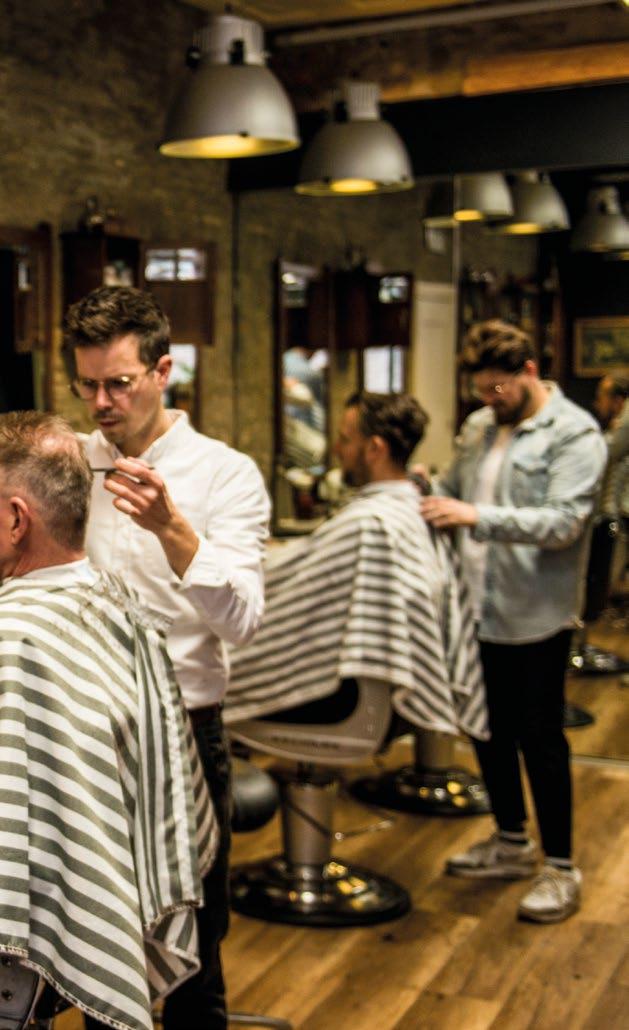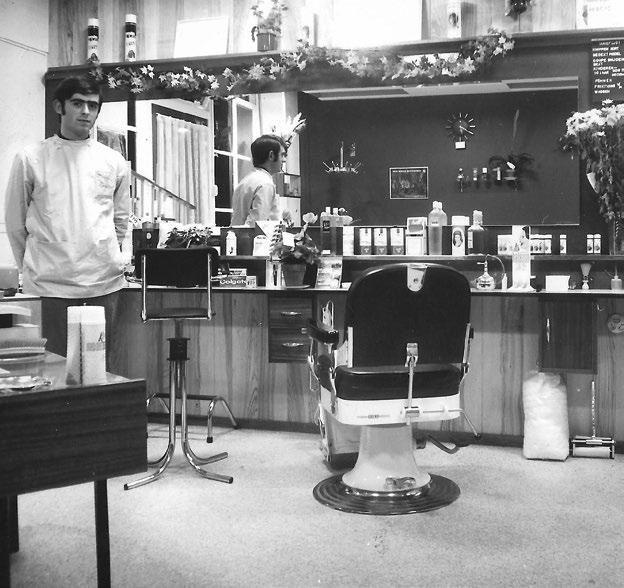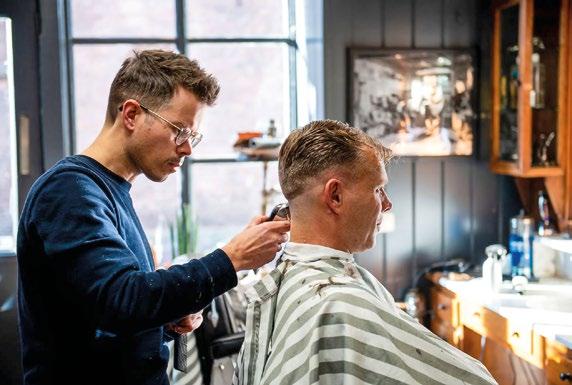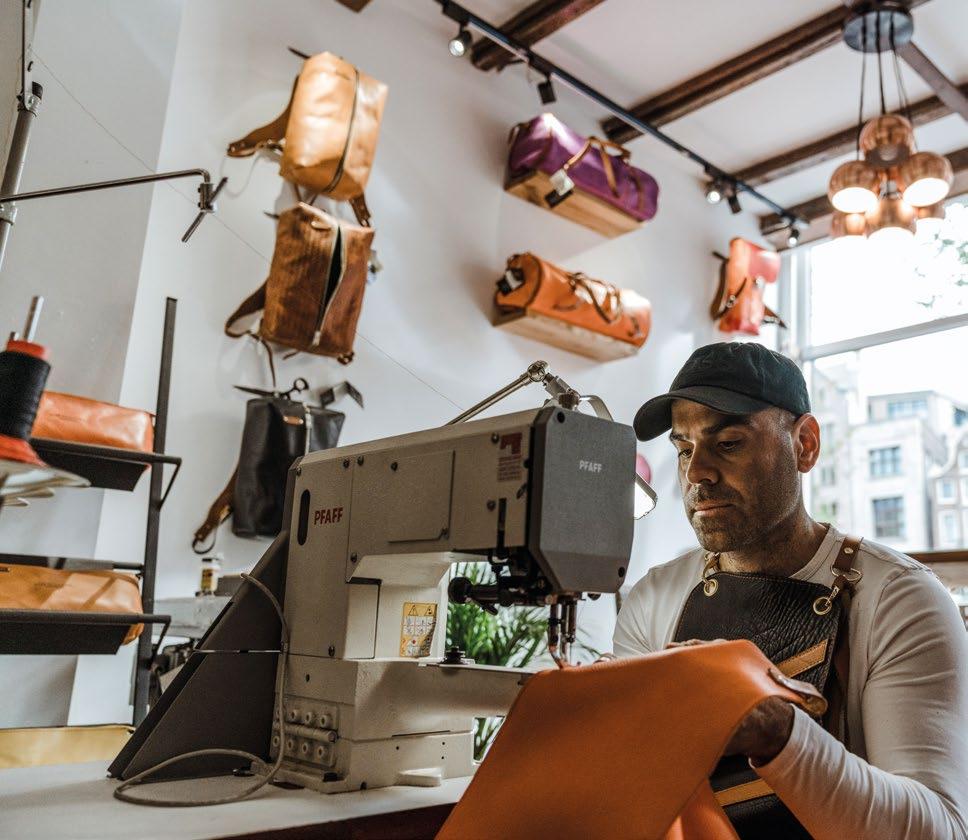
6 minute read
ALL IN THE FAMILY Interview with Wim Broekhuis & Martin Leusink
WHAT IS SAID IN THE BARBERSHOP, STAYS IN THE BARBERSHOP
Wim Broekhuis was a second-generation barber in the Dutch town of Elburg until he was involved in an awful road accident and had to sell the four businesses he had built up with his wife. His nephew Martin was just a boy at the time, but at the age of 20 he took over the barbershop his uncle had opened in 1970. He turned it back into a traditional barbershop and resumed the family barbering tradition.
INTERVIEW WITH MARTIN LEUSINK & WIM BROEKHUIS OF KAPPER MARTIN HERENKAPPERS IN ELBURG, THE NETHERLANDS

Shaving assistant Wim: “My grandfather was a clogmaker in Barneveld, but my father moved to Nunspeet. That’s where he met my mother at a local choir, and they opened a barbershop and a household items shop in 1938. I was the youngest of seven children. I remember that only shaves were given on Saturday and that my brother and I would help with the lathering. We’d lather up the gentlemen and my father would then follow with his razor. At the time it was perfectly normal to get a shave once or twice a week. Each shaving client had his own shaving brush that was kept in a drawer. I ended up being the only one in the family to become a barber.”
“At the time I didn’t know what line of work I wanted to go into and that’s when my dad said: ‘Why not become a barber?’ So that’s what I decided to do. That’s just the way it went in those days. I attended hairdressing college in Amsterdam. I would go to college in the mornings and work in the salon in downtown Amsterdam in the afternoons.”
This barbershop located where my uncle started out is a dream come true
Opening the barbershop in Elburg Long hair was in fashion during that period, which led to a growing number of mixed salons. Even though Wim had earned his diploma for both women’s and men’s hairdressing (which were two separate studies at the time), he consciously opted for men’s hairdressing. Wim explains: “I was really attracted to the technique that goes into men’s haircuts. My first job after graduating from college was a barber at a military base. I was able to apply the technique I’d learned there to longer hair styles as well. After that I worked for a while at a salon in Deventer, before opening my own barbershop in Elburg. I remember clear as day that my rent was 30 guilders a week, which is about 14 euros. My dad thought it would be better for me to start my own place rather than working for him, because he wanted to keep family and business separate and I agree with him. I was the first person to open a ‘modern’ salon in Elburg.”
“The salon became a real gathering place. I remember the mayor and several town council members all coming by the same afternoon to get a haircut because they were having a meeting that evening. One of them said that they’d might as well cancel the meeting because everything had already been discussed in the barber shop! But we kept everything that was said in the barbershop to ourselves and our clients knew that. So they felt safe.” Expansion The salon was successful from the outset. Business was, in fact, so good that he soon opened a second salon that was primarily for women. Wim had in the meantime completed the women’s hairdressing programme in Utrecht, but it simply wasn’t his thing. In fact, he hated setting curls with rollers to create coiffures so much that he literally threw his curler pins and curlers together with his diploma in the canal! He decided then and there to focus completely on barbering. He also decided it was better to keep the salons for men and women separate like they had been in the past. But permanents were also popular for men back in the seventies. And the fact that many men’s hairdressing didn’t know how to do permanents led to the creation of more and more mixed salons. Wim and his wife ultimately had four successful salons. Wim was active in the sector, serving as chairman of a professional hairdresser’s association in Zwolle. He also trained numerous barbers, with several of them going on to win prizes at competitions. Everything was going great until that dreadful day in 1994.
Wim Broekhuis in the barbershop at Jufferenstraat 7 in Elburg in 1970.

A tragic accident Wim accompanied his wife on a choir trip to Vienna and on the way their coach was involved in a tragic accident. Seven people lost their lives. Wim fortunately survived the accident. He was, however, seriously injured and was no longer able to work as a barber. The salons were transferred to his employees and Wim was in rehabilitation for many years. This could have marked the end of the hairdressing dynasty, but Wim had his nephew Martin, who he knew had wanted to be a barber since childhood.
It was now 2002 and Martin began hairdressing college. Wim mentioned to him at a birthday party that the salon located on the Jufferenstraat in Elburg was for sale. Wim asked his nephew straight up if he might be interested in acquiring the salon. Martin was a little taken aback because he had not even finished his training and was only 20 years old. But Wim didn’t see that as a reason not to go for it: “I was 19 when I started out.” Martin was convinced and that’s how he resumed the family tradition.
Back in the family Martin continues: “The sociability and interaction with clients at my uncle’s barbershop really appealed to me and it was secretly my dream to work for him one day. Even though things turned out differently, I still ended up going to hairdressing college. So when my uncle put me on the spot at that birthday party, I grabbed my opportunity. I started working three days a week at the barbershop and would go to college two days a week. I was actually supposed to have an apprenticeship one day a week, but fortunately my work in my own salon was counted as an apprenticeship. And that’s how I got started eighteen years ago.” Wim Broekhuis (left) with his father Co Broekhuis (right).

Co Broekhuis opening the barbershop on Jufferenstraat in Elburg.

Co Broekhuis’ salon in Doornspijk in the 1970s - 1980s.

The Kapper Martin Herenkappers barbershop in Elburg today.

Open to everyone “The really amazing thing about my barbershop is that all kinds of people come here. Just like in the past, it still serves as a great gathering place where people from all walks of life come in for a haircut, a coffee and a good conversation. Our door is always open to everyone. I think it’s so important that as a barber you genuinely give each client the attention they deserve and really listen to them. I’ve witnessed the rise of barbershops from the beginning and I think it’s great! I expect to see even more separate men’s and women’s salons in the future. I’m thrilled that teenage boys as young as fourteen want to go to the barbershop!”
Martin Leusink at work. Nice to know
Specialities include hair styling and beard grooming
The barbershop has four workstations
Haircuts for € 21
Open 5 days a week (from 7:15 a.m.!), closed on Sunday and Monday
Appointments only
Favourite brands: 1922 by J.M. Keune,
Artistique and Proraso

Kapper Martin Herenkappers Jufferenstraat 7 8081 CP Elburg The Netherlands 0525 681 104 www.kapperelburg.nl @kappermartin










